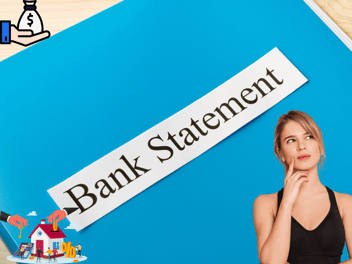19 min read
.png)
Key Takeaways
- Qualify using 12–24 months of bank statements instead of tax returns or W-2s for faster approvals
- Access up to 85–90% of your home's equity with revolving credit and interest-only payment options
- Close in 5–7 days with digital underwriting, often without in-person appraisals or complex documentation
If you're a self-employed business owner watching your monthly deposits pile up while your tax returns tell a completely different story, you're not alone. What if you could qualify for a home equity line of credit using the same bank statements that show your actual cash flow, without handing over tax returns that don't reflect your true earning power?
A Bank Statement HELOC lets self-employed borrowers access up to 85–90% of their home's equity using 12–24 months of bank deposits.
Companies like Truss Financial Group help entrepreneurs and self-employed nationwide unlock their equity in as little as 5–7 business days, often without an in-person appraisal.
Let's explore how Bank Statement HELOCs work, who they're designed for, and how they compare to traditional home equity financing options.

Why Self-Employed Borrowers Need Bank Statement HELOCs?
The Problem with Traditional Income Documentation
Here's the reality: if you're self-employed, your tax returns probably look nothing like your actual income. Why? Because smart business owners take legitimate deductions for equipment, travel, home office expenses, vehicle costs, and more. While these write-offs reduce your tax burden (which is great), they also dramatically lower your reported income on paper.
Traditional lenders look at your adjusted gross income (AGI) on your tax returns to determine how much you can borrow. So even if you're depositing $20,000 every month into your business account, your tax return might only show $70,000 in taxable income after deductions. To a conventional bank, you don't earn enough to qualify for a meaningful credit line.
Example: Maria owns a successful marketing consultancy. She generates $25,000 in monthly deposits, $300,000 annually in cash flow. But after writing off software subscriptions, contractor payments, business meals, and her home office, her taxable income drops to just $85,000.
A traditional HELOC lender would use that $85,000 figure, severely limiting her borrowing power. A Bank Statement HELOC, however, looks at her actual deposits, capturing her true earning capacity.
Bank statement lending solves this problem by focusing on what's really happening in your accounts, your actual cash flow, rather than what you reported to the IRS.
Understanding Home Equity and How It Works
Before diving into Bank Statement HELOCs specifically, let's clarify what home equity actually means.
Home equity is the portion of your home you truly own, calculated as:
Home Equity = Current Market Value - Outstanding Mortgage Balance

For example, if your home is worth $600,000 and you owe $300,000 on your mortgage, you have $300,000 in equity. A HELOC allows you to borrow against a portion of that equity without selling your home or refinancing your existing mortgage.
How Lenders Determine Your Available Equity
Lenders use something called a loan-to-value (LTV) ratio to determine how much they're willing to lend. With Bank Statement HELOCs, you can typically access up to 85–90% of your home's value, minus what you still owe.
Using our earlier example:
- Home value: $600,000
- 85% LTV = $510,000
- Minus existing mortgage: -$300,000
- Available credit line: $210,000
Automated Valuation Models (AVMs)
Here's another advantage: many Bank Statement HELOC programs use Automated Valuation Models instead of requiring a full in-person appraisal (no appraisal HELOC). AVMs analyze recent comparable sales, property records, and market conditions to estimate your home's value digitally. This speeds up approval and reduces costs, another reason these loans close faster than traditional options.
How Bank Statement HELOCs Work
Let's walk through the process step-by-step so you understand exactly how lenders evaluate your application.

Step 1: Submit Your Bank Statements
You'll provide 12 to 24 months of consecutive bank statements, either business or personal, but not a combination of both. Lenders want to see consistent deposit patterns that demonstrate reliable cash flow.
Step 2: Income Calculation
Here's where Bank Statement HELOCs differ dramatically from traditional loans. Instead of looking at your W-2 or tax return, lenders:
- Add up your total monthly deposits over the statement period
- Calculate your average monthly deposit
- Apply an expense ratio (typically 50% for business accounts, meaning they count half your deposits as income to account for business expenses)
- The result becomes your qualifying income
Example: If your business account shows $180,000 in total deposits over 12 months, that's $15,000 per month on average. With a 50% expense ratio, your qualifying income would be $7,500/month or $90,000 annually, significantly higher than what might show on your tax return after deductions.
For personal bank statements where you're depositing after-tax income (or transferring from business to personal accounts), lenders may count 100% of deposits since business expenses have already been accounted for.
Step 3: Property Valuation
Your property value is verified digitally through an AVM, or in some cases with a traditional appraisal. This determines your available equity and maximum credit line.
Step 4: Credit and Underwriting Review
Lenders review your credit profile (minimum 620 credit score typically required) and verify that you have sufficient equity. Some programs require reserves, usually 3 to 6 months of principal, interest, taxes, and insurance (PITI) set aside in savings.
Step 5: Approval and Access
Once approved, you enter the draw period, typically 10 years, during which you can access funds as needed up to your credit limit. You'll make interest-only payments during this time on whatever amount you've borrowed.
After the draw period ends, you enter the repayment period (often 20 years), where you'll pay both principal and interest to pay off the remaining balance.
Truss Financial Group streamlines this entire process with digital tools, including Plaid verification for instant bank statement uploads and e-notary closings, allowing many borrowers to close in under a week.

Benefits of a Bank Statement HELOC
Why are self-employed borrowers increasingly turning to Bank Statement HELOCs? Here are the key advantages:
- No tax returns or W-2s required – Qualify based on actual cash flow, not taxable income
- Quick approvals – Many loans approved in 5-7 business days
- Revolving line of credit – Borrow what you need, repay, and borrow again during the draw period
- Interest-only payments during the draw period – Lower monthly payments while accessing funds
- Access equity without refinancing – Keep your existing low-rate first mortgage intact
- High credit limits – Loan amounts & HELOC up to $750,000 through specialized lenders
- Often, no in-person appraisal is required – AVMs speed up the process and reduce costs
- Flexible use of funds – Home improvements, business expansion, debt consolidation, investment opportunities, no restrictions
Think of a Bank Statement HELOC as a reusable credit card backed by your home's value. You only pay interest on what you actually use, and you can tap into it repeatedly during the draw period.
Bank Statement HELOC vs Traditional HELOC
Key Differences Table
|
Feature |
Traditional HELOC |
Bank Statement HELOC |
|
Income Documentation |
W-2s / Tax Returns |
12-24 months of Bank Statements |
|
Borrower Type |
Salaried Employees |
Self-Employed / Entrepreneurs |
|
Appraisal |
Always Required |
Often Automated (No In-Person Appraisal) |
|
Max LTV |
80% |
85-90% |
|
Minimum Credit Score |
700+ |
620+ |
|
Funding Speed |
2-4 weeks |
5-7 days |
Unlike traditional loans that rely on adjusted gross income from tax returns, a Bank Statement HELOC measures your true earning power through actual deposits. This makes it ideal for business owners, freelancers, consultants, and anyone whose reported income doesn't reflect their real cash flow.
When to Choose Each Option
Choose a Traditional HELOC if:
- You're a W-2 employee with steady paychecks
- Your tax returns accurately reflect your income
- You don't mind the longer approval timeline
- You want the lowest possible interest rate (though rates are competitive)
Choose a Bank Statement HELOC if:
- You're self-employed or own a business
- You write off significant business expenses
- Your deposits far exceed your taxable income
- You need faster access to funds
- You want to avoid the hassle of gathering tax documents
Other Non-Traditional Loan Options to Explore
Bank Statement HELOCs aren't your only option as a self-employed borrower. Here are other flexible financial products worth considering:

1. No-Doc HELOC (No Tax Return Option)
A no-doc HELOC takes alternative income verification even further, qualifying you based on assets or stated income rather than bank statements. This "no income verification mortgage" works well for retirees, investors with significant assets, or entrepreneurs with complex income structures.
While Bank Statement HELOCs verify income through deposits, no-doc options may look at investment portfolios, retirement accounts, or other assets.
2. DSCR Loans for Real Estate Investors
If you're investing in rental properties, Debt Service Coverage Ratio (DSCR) loans qualify you based on the property's cash flow rather than your personal income. The lender calculates whether the rental income covers the mortgage payment. Unlike a Bank Statement HELOC that taps your primary residence's equity, DSCR loans finance investment properties directly.
Looking for loans for your investment property?
Truss Financial Group specializes in DSCR loans for borrowers with a DSCR below 1!
Get started HereWe won’t sell your data.
Asset Depletion Mortgages for Retirees
Asset depletion loans convert your savings, investments, and retirement accounts into qualifying income. Lenders divide your total assets by a set number (often 360 months) to create a monthly income figure. This option works well for retirees or individuals with substantial assets but limited monthly deposits, a different approach from bank statement lending, which focuses on cash flow.
Bridge & Fix-and-Flip Loans
Real estate investors often use short-term bridge loans or fix-and-flip financing to purchase, renovate, and sell properties quickly. These loans are typically 6-24 months and aren't secured by your primary residence like a HELOC. They're ideal for quick property turnarounds rather than ongoing access to funds.
Each of these alternatives serves different borrower profiles, but Bank Statement HELOCs remain the top choice for self-employed homeowners who want to leverage their primary residence's equity using actual cash flow documentation.

Cash-Out Refinance vs Bank Statement HELOC
Should you refinance your entire mortgage or take out a second mortgage through a HELOC? Here's how to decide.
When a Bank Statement HELOC Makes More Sense
If you're locked in a low fixed rate on your existing mortgage, say, 3% or 4%, the last thing you want to do is refinance into today's higher rates.
A Bank Statement HELOC acts as a second mortgage, allowing you to access additional funds while preserving your favorable first-mortgage rate.
Example: You owe $250,000 at 3.5% on a home worth $600,000. If you did a cash-out refinance for $400,000, you'd be paying today's rates (potentially 7%+) on the entire $400,000 balance. With a HELOC, you keep your $250,000 first mortgage at 3.5% and only pay the current rate on the additional $150,000 you borrow through the credit line.
When Cash-Out Refinancing Makes Sense?
Cash-out refinancing might be better if:
- Current mortgage rates are close to what you're already paying
- You want one single monthly payment
- You prefer a fixed rate on the entire loan amount
- You're consolidating high-interest debt
Both options let you access funds from your home's equity, but a Bank Statement HELOC provides more flexibility and preserves low existing mortgage rates, making it the smarter choice in many market conditions.
Looking for Cash Out Refinance? Get a free rate quote
Get started in less than 1 minuteEligibility Requirements and Loan Terms
Wondering if you qualify? Here's what lenders typically look for with Bank Statement HELOCs:
Eligibility Checklist:
- 620+ credit score (higher scores may qualify for better terms)
- 12-24 months of business or personal bank statements
- 15-20% equity minimum (80-85% LTV maximum)
- Loan amounts from $100,000 to $750,000
- Primary residences, second homes, and investment properties are all eligible
- Fixed or variable rate options available
- Typical draw period of 10 years; repayment over 20 years
- PITI reserves (3-6 months of mortgage payments in savings)
Important Note: All loans are subject to underwriting review and ability-to-repay guidelines. Lenders must verify that you have the financial capacity to manage the credit line responsibly.
Real-World Example
Let's bring this to life with a real borrower scenario:
David's Story:
David runs a successful marketing consultancy in Austin, Texas. His business generates a consistent monthly revenue of $20,000 in deposits, $240,000 annually. However, after legitimate business deductions for software, contractors, travel, and his home office, David's taxable income on his tax return shows only $70,000.
When David approached traditional banks for a HELOC, he was offered minimal credit lines based on his reported income. Frustrated, he discovered Bank Statement HELOC programs.
Using 12 months of his business bank statements, Truss Financial Group calculated his qualifying income at $10,000/month (50% of his $20,000 average deposits, accounting for business expenses). This gave him enough qualifying income to access a $250,000 HELOC against his home's $600,000 value.
The entire process took less than a week, no tax returns required, no in-person appraisal, and David closed with an e-notary from his home office. He used the funds to invest in a rental property and expand his business, all while keeping his 3.75% first mortgage rate intact.
Conclusion
Bank Statement HELOCs provide a smart, flexible solution for self-employed homeowners who need to access their home's equity but face challenges with traditional income documentation.
By qualifying based on actual bank deposits rather than tax returns, these specialized loans capture the true financial picture of business owners, freelancers, and entrepreneurs.
If you're ready to unlock your home's equity without the red tape of traditional lending, explore your options with specialized non-QM lenders who understand the unique needs of self-employed borrowers.
Bank statement lending isn't just an alternative; it's often the best way for business owners to achieve their financial goals.
Ready to get started? Connect with experienced lenders who specialize in Bank Statement loans and HELOCs and discover how quickly you can access the equity you've worked hard to build.
FAQs
Can I get a HELOC with bank statements?
Yes! Bank Statement HELOCs are specifically designed for self-employed borrowers who want to qualify using 12-24 months of business or personal bank statements instead of tax returns. Lenders calculate your income based on average monthly deposits, making it easier for business owners to qualify based on actual cash flow.
Why is a 6-month bank statement required?
While some lenders may accept 6 months, most Bank Statement HELOC programs require 12-24 months of statements to establish a reliable pattern of income. The longer period gives lenders confidence in your consistent earning capacity and reduces risk.
What looks bad on bank statements for a mortgage?
Lenders watch for red flags, including frequent overdrafts, non-sufficient funds (NSF) fees, irregular large deposits without explanation, excessive gambling transactions, and evidence of unreported income sources. They also exclude "disallowed deposits" like transfers between your own accounts, loan proceeds, and one-time windfalls that don't represent regular income.
How many months of bank statements for HELOC?
Most Bank Statement HELOC programs require 12 to 24 months of consecutive bank statements. Some specialized programs may accept fewer months, but longer periods typically result in more favorable terms and higher credit limits.
Can you get a HELOC with bank statements?
Absolutely, Bank Statement HELOCs exist precisely for this purpose, allowing self-employed borrowers to qualify using bank deposits rather than traditional income documentation like W-2s or tax returns.
Why are banks getting rid of HELOC?
Some traditional banks have reduced HELOC offerings due to regulatory concerns and market volatility, but specialized non-QM lenders continue to offer robust HELOC programs, including Bank Statement HELOCs, specifically tailored to self-employed borrowers and real estate investors.
Can I get a loan with just bank statements?
Yes, Bank statement loans (both HELOCs and purchase or refinance mortgages) allow you to qualify using only bank statements. This includes Bank Statement Purchase Loans, Bank Statement Refinance Loans, Bank Statement HELOCs, and more, all designed for borrowers whose income isn't fully reflected on tax returns.
Table of Content

Take your pick of loans
Experience a clear, stress-free loan process with personalized service and expert guidance.
Get a quote



